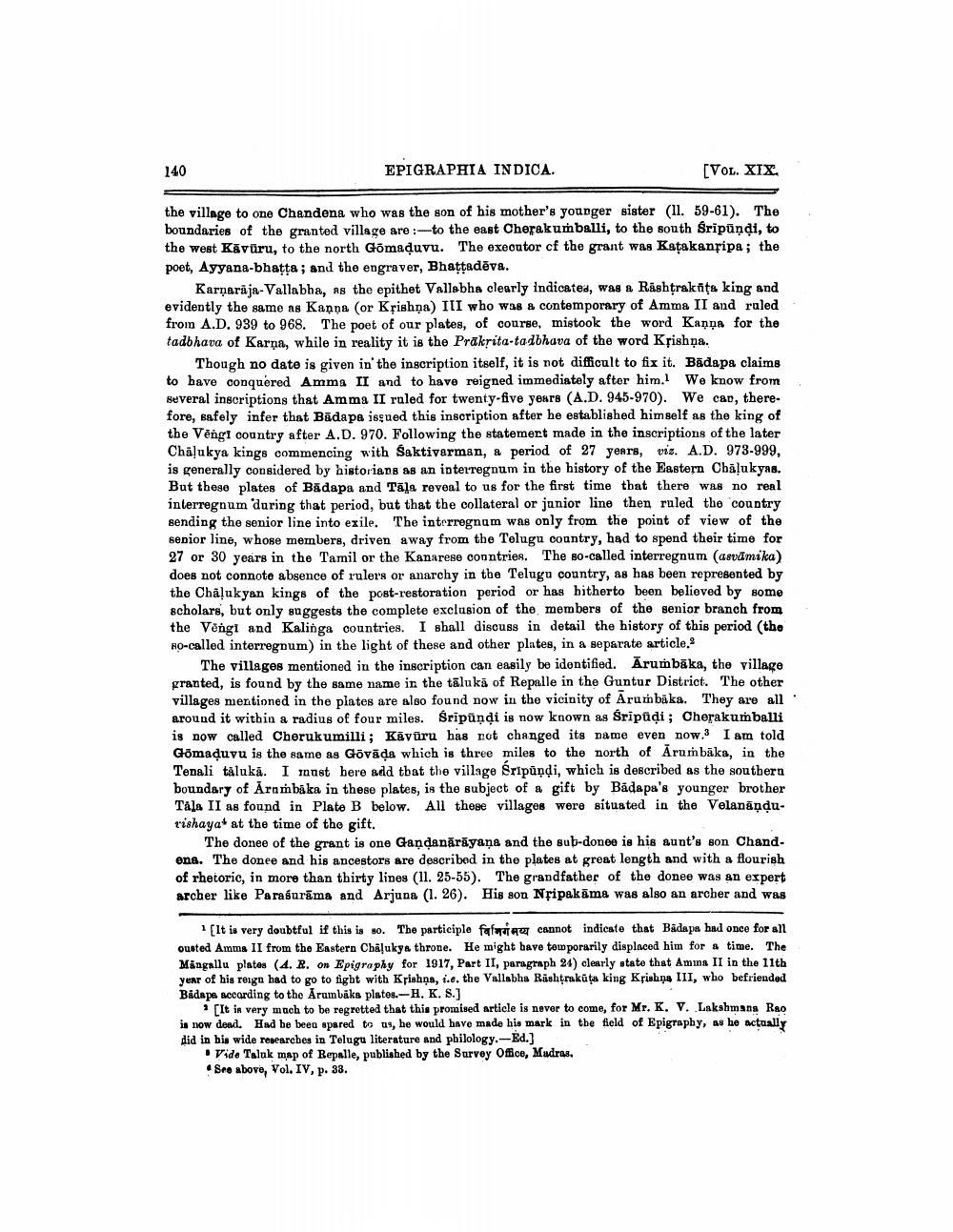________________
140
EPIGRAPHIA INDICA.
[VOL. XIX.
the village to one Chandena who was the son of his mother's younger sister (11. 59-61). The boundaries of the granted village are :--to the east Cherakumballi, to the south Sripündi, to the west Kāvüru, to the north Gomaduvu. The executor of the grant was Katakansipa; the poet, Ayyana-bhatta ; and the engraver, Bhattadēva.
Karnarāja-Vallabha, as the epithet Vallabha clearly indicated, was a Rashtrakūta king and evidently the same as Kanna (or Krishna) III who was a contemporary of Amma II and ruled from A.D. 939 to 968. The poet of our plates, of course, mistook the word Kanna for the tadbhava of Karna, while in reality it is the Prākrita-tadbhava of the word Křishņa.
Though no date is given in the inscription itself, it is not difficult to fix it. Bådapa claims to have conquered Amma II and to have reigned immediately after him. We know from several inscriptions that Amma II ruled for twenty-five years (A.D. 945-970). We car, there. fore, safely infer that Bāda pa issued this inscription after he established himself as the king of the Véngi country after A.D. 970. Following the statemert made in the inscriptions of the later Chāļukya kings commencing with Saktivarman, a period of 27 years, vis. A.D. 973-999, is generally considered by historians as an interregnum in the history of the Eastern Chăļukyas. But these plates of Badapa and Tāla reveal to us for the first time that there was no real interregnum during that period, but that the collateral or junior line then ruled the country sending the senior line into exile. The interregnum was only from the point of view of the senior line, whose members, driven away from the Telugu country, had to spend their time for 27 or 30 years in the Tamil or the Kanarese countries. The so-called interregnum (asvāmika) does not connote absence of rulers or anarchy in the Telugu country, as has been represented by the Chāļukyan kings of the post-restoration period or has hitherto been believed by some scholars, but only suggests the complete exclusion of the members of the senior branch from the Vèngi and Kalinga countries. I shall discuss in detail the history of this period (the RO-called interregnum) in the light of these and other plates, in a separate article.
The villages mentioned in the inscription can easily be identified. Ārumbāka, the village granted, is found by the same name in the tālukā of Repalle in the Guntur District. The other villages mentioned in the plates are also found now in the vicinity of Arun baka. They are all around it within a radius of four miles. Sripūņdi is now known as Sripudi; Cherakumballi is now called Cherukumilli; Kāvīru has not changed its name even now. I am told Gömaduvu is the same as Gövāda which is three miles to the north of Ārumbāka, in the Tenali taluka. I must bere add that the village Sripūndi, which is described as the southern boundary of Arambáka in these plates, is the subject of a gift by Bädapa's younger brother Tåla II as found in Plate B below. All these villages were situated in the Velanāņdurishayat at the time of the gift.
The donee of the grant is one Gandanārāyana and the sub-donee is his aunt's son Chandena. The donee and his ancestors are described in the plates at great length and with a flourish of rhetoric, in more than thirty lines (11. 25-55). The grandfather of the donee was an expert archer like Parasurāma and Arjuna (1. 26). His son Nfipakāms was also an archer and was
[It is very doubtful if this is so. The participle fafering cannot indicate that Bädapa had once for all ousted Amma II from the Eastern Chāļukya throne. He might have temporarily displaced him for a time. The Mingallu plates (4. R. on Epigraphy for 1917, Part II, paragraph 24) clearly state that Amina II in the 11th year of his reign had to go to fight with Krishna, i.e. the Vallabha Rashtrakūta king Krishna III, who befriended Bidapa according to the Arumbāks plates.-H. K. S.]
[It is very much to be regretted that this promised article is never to come, for Mr. K. V. Lakshmana Rao in now doad. Had be been spared to us, he would have made his mark in the field of Epigraphy, as be actually did in bia wide researches in Telugu literature and philology.-Ed.]
• Vide Taluk map of Repalle, published by the Survey Office, Mudras. • Sre above, Vol. IV, p. 38.




